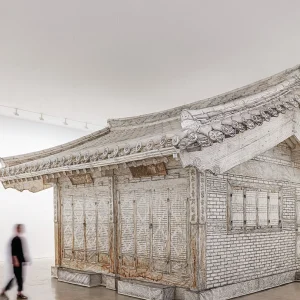
Zeuler Rocha Mello De Almeida Lima.
Foreword by Barry Bergdoll Yale University Press, £40.00
Review by Rowan Moore
One of the many colourful characters with whom Lina Bo Bardi had to deal in the course of her colourful life was Juracy Magalhães: army general, president of Brazil’s national oil company, and eventually successful candidate for the governorship of the state of Bahia.
He also played an editorial role in a newspaper to which Bo Bardi contributed. How’s that for conflicts of interest? It makes the multiple hat-wearers of modern British architectural politics look like rank amateurs.
Magalhães embodies the tangled networks that Bo Bardi had to negotiate and manipulate to achieve her many and varied works, and it is one of the strengths of Lima’s careful and factual biography of her that figures like this are given their place. She is not shown as a maestro, producing masterpieces in an apolitical void, but as someone whose life was an open-ended exploration buffeted by wars and revolutions, whose next episodes were always uncertain, who sometimes had to duck and weave, but who through it all was guided by powerful beliefs and values.
This consistency of purpose in compromised settings is true heroism, especially when compared with Ayn Rand’s model in The Fountainhead, of the lone genius pitting his vision against the world. For Bo Bardi, the core belief was in the social and cultural role of architecture, accompanied by a faith in the productions of the untrained and the poor. She devoutly held the view that architecture should be popular, not elitist, and lived out the implications of that view as fully as she could. This did not mean that professional skill and knowledge were unimportant — and if she were judged only by her formal brilliance and innovation she would still be an important figure — but only that she gave these qualities no special privilege.

Architecture, she said, is ‘an adventure in which people are called to intimately participate as actors’. Her view of architecture as something enmeshed and engaged meant, among other things, that many of her works were not actually buildings, but included exhibition design and curatorship, journalism, and design for stage sets and furniture. She was as multiple as Magalhães indeed, but more noble.
Lima communicates this multiplicity, too, showing Bo Bardi as more than the architect of the three concrete buildings in São Paulo that make her look most like the normal idea of a modern architect, and for which she is best known — her Glass House, the Museum of Art, and the sports and cultural centre SESC Pompeia. Spellbinding though these projects are, they are only part of the story, and Lima is good on Bo Bardi’s life and more subtle work in Salvador de Bahia, a place which she found more vital than the business city of São Paulo.

The book gives due space to the houses and churches which, departing from conventional modernism, used textured masonry and rough timber. It shows how Bo Bardi was as radical in converting existing buildings as with new build, and could use scaffolding or blue paint as powerfully as cantilevers and wide-spanning reinforced concrete. Lima also brings out the ferocity of her opposition to Oscar Niemeyer, whom she saw as a purveyor of empty form-making, pompous and meaningless, whose Ibirapuera complex was ‘an embarrassment, a provincial, ignorant, and reactionary humiliation’.
The writer delves gingerly into her personal life, revealing a possible affair with Mussolini’s leading architect Marcello Piacentini, and an attraction on Gio Ponti’s part that was ‘more than professional’. Lima is not really a romantic writer, however, and he leaves you wanting to know more.
The book’s weakness, in fact, is a murky and pedantic prose style, that is the downside of its conscientious fact-gathering and doesn’t match the vivacity and audacity of its subject. There are great stories in there about a spectacular person, but it is a laborious wade to find them. But this flaw is outweighed by the book’s usefulness as the first to assemble into a single narrative the full span of Bo Bardi’s life and work, in all its multiple aspects.
It hardly needs saying that it is timely. At her Glass House not so long ago I saw among the recent entries to the visitors’ book the names of Lord Foster and family, and Julia Peyton- Jones, director of the Serpentine Gallery. This confirmed to me that the rapid rise in her reputation in recent years has reached the highest possible levels. A few years ago, architects and critics who should have known better would look blank when her name was mentioned. Now everyone wants to know more about the architect whose position, so opposed to the corporate, the globalised, and what would now be called ‘iconic’, looks so pertinent.





